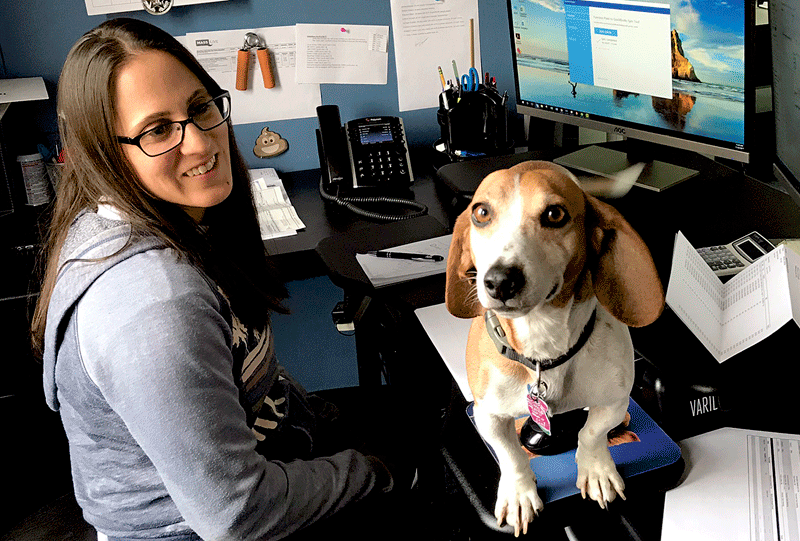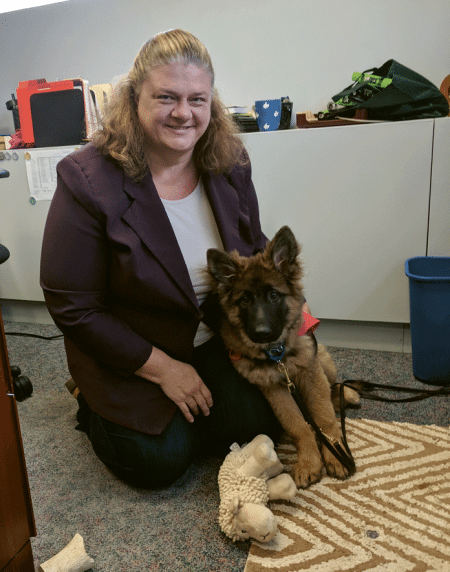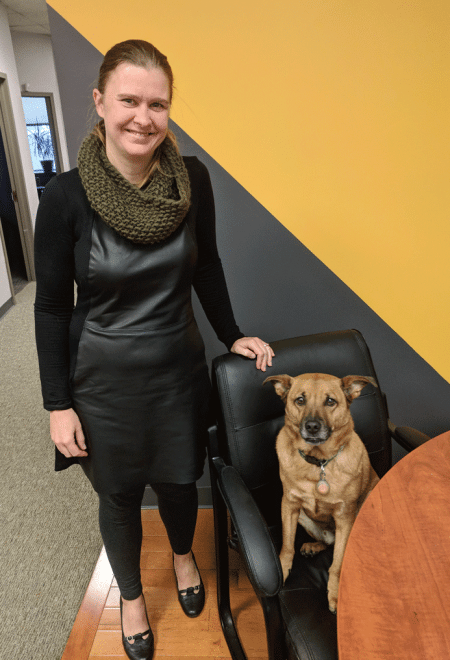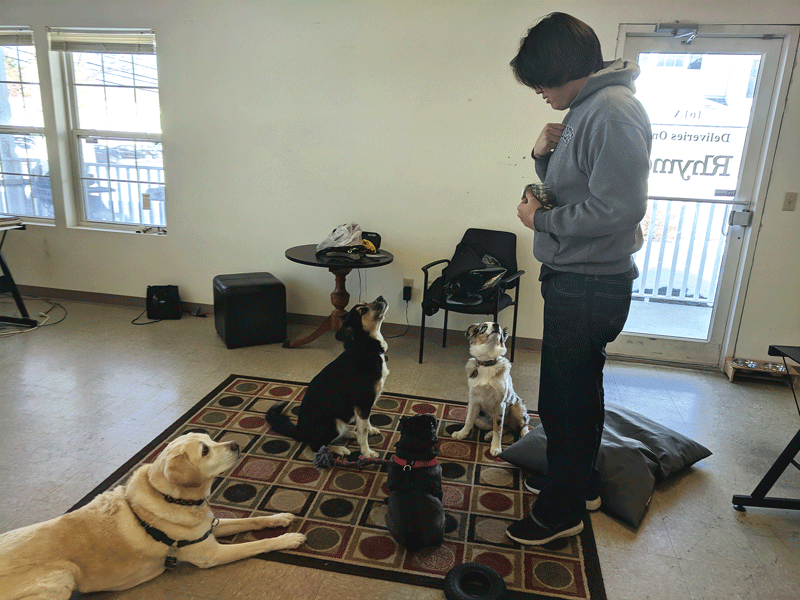
More Companies See the Benefits of Dogs in the Office
Paws for Effect

Lauren Mendoza gets plenty of work done at Inspired Marketing, at least after Finn gives her mouse back.
To some employers, the very idea of having employees’ dogs roaming about the office every day seems absurd. How would anyone get any work done? Would they pester clients and other visitors? But many area businesses that welcome pets into the company culture say the benefits — reduced stress and a sense of lightness and fun leading to more productivity, not less — definitely outweigh any drawbacks.
Maxwell Vondogenburgen (Max for short) came into Jill Monson-Bishop’s life around the time she launched her company, Inspired Marketing, in 2009.
Right from the start, neglecting one for the other was out of the question.
“Since I got Max, we’ve had a dog culture here,” Monson-Bishop said, while Max came sniffing around to check out the reporter visiting the company’s Maple Street office in Springfield. “It was almost necessary because some of the staff have dogs, and I want them to give me their all; I want them to be present and be here, and it helps from a logistical standpoint for the dog parents not to worry about running home at lunch or getting home before 5 to let them out.”
When you’re stressed, there’s nothing like being able to sit on the floor and have this unfiltered love of a dog. He doesn’t judge your deadline or your creative work. A dog just licks you, and everything else just melts away.”
But the benefits extend far beyond that, she added.
“It grew into what the dogs did for us. When you’re stressed, there’s nothing like being able to sit on the floor and have this unfiltered love of a dog. He doesn’t judge your deadline or your creative work. A dog just licks you, and everything else just melts away. Everyone thinks creatives are super fun, and obviously, we have fun, but there are elements of stress to our jobs, too. And dogs are great for that.”
Max’s title on the Inspired Marketing website is ‘employee satisfaction manager,’ which implies a broad set of responsibilities for someone getting paid in food, treats, and ear scratches. He’s joined in the office by two other mixed breeds: Monson-Bishop’s second dog, Vinnie — the ‘customer experience associate’ — and Finn, the firm’s ‘siesta manager,’ who belongs to Operations Manager Lauren Mendoza. Other dogs have come and gone over the years as well.

Deb O’Brien has been bringing Fidelco dogs to work for well over a decade, providing educational opportunities for both the dogs and her fellow TD Bank employees.
As a result, when a client visits, they might be greeted by barking, but the dogs are behind a locked door, so no one gets jumped. Visitors are also asked if they have a problem with dogs before meeting any. “Almost everyone says no,” Monson-Bishop said. “Sometimes, during a meeting, a dog will try to get up on somebody, and we get them down, and most times the person is like, ‘oh no, it’s fine.’ It’s nice — sometimes meetings can be intense, and when we introduce a dog, it lightens the mood and can help us be more creative.”
Meghan Lynch didn’t have a dog when her advertising agency, Six-Point Creative, was getting off the ground, and one of the key considerations when adopting one was not having to leave the pet at home. “To me, there was no point in having a dog and bonding with him and then leaving him home alone for eight to 10 hours a day.”
So she talked to her partners about accommodating a dog at work, and everyone was willing to give it a shot. Five and a half years later, Dexter is a fixture in the office on Hampden Street in downtown Springfield. Meanwhile, he’s joined some of the time by Quincy and Goose, the fur babies of Senior Director Scott Whitney and Senior Designer Meghan Mason.
“It’s worked out really well, and it’s good for socialization because he’s coming into contact with different people all day long,” Lynch said. “Getting used to all the people coming in and out, and me going in and out, has made him a calmer, happier dog.”
And the feeling is reciprocal.
“From our standpoint, it means a lot having him around, especially if I’m having a tough day,” she said. “And for new employees, it’s a signal that we value work-life balance. We understand that you only have one life — you don’t have a work life and a home life; you have a life.”
When Blair Winans launched Rhyme Digital in 2011, he searched for a workspace that allows dogs, before finding one at Eastworks in Easthampton. When the digital-marketing company needed more space, he moved to an available building on Route 10 and brought the canine crew — four were in the office the day BusinessWest visited — with him.
“For me, it was the convenience of not leaving my dog at home, having to check on him, going back and forth. I had never worked in an environment that would have dogs at the office, but as employees came on here, I said, ‘my dogs are here; feel free to bring your dogs.’”
That’s why Winans’ lab, Butters, and pug, Flora, get to hang out with Design Master Ian Reed’s husky mix, Maggie, and Marketing Analyst Dan Taylor’s Aussie puppy, Ellie, instead of sitting quietly at home.
“I feel they supply so much comic relief,” Winans said. “When we’re in a meeting and Butters is trying to be the center of attention and barking at something going on outside the door, it’s just part of the environment here.
“And our clients get it,” he went on. “When I’m on a conference call and a dog is barking in the background, they ask, ‘which one is that?’ No matter how stressful things are, when these guys are begging for attention and trying to make you laugh, that’s an extension of what we want as a company culture. Our employees are part of a business, but they’re also part of a family.”
Tails to Tell
Businesses that are opening their arms to that concept of family and dog culture are a growing breed (pun intended). The Society for Human Resource Management’s Employee Benefits survey in 2015 found that 8% of respondents reported that their workplaces permitted pets, an increase from 5% in 2013.
A report published this year in the International Journal of Environmental Research and Public Health cited a recent study on the effects of dogs in the workplace on stress and well-being. In the study, employees who did and did not bring dogs to work completed a perceived stress survey several times throughout the workday. Employees who did not bring dogs to work had significantly higher perceived stress than employees who did. To assess differences in stress, employees who brought their dogs to work were instructed to leave them at home two days a week during the one-week study period. On days when employees in the dog group did not bring their dogs to work, their stress levels increased throughout the day, matching the pattern of employees who never brought dogs to work.
Lynch is a believer in that effect, but conceded that the dogs themselves need to get along — which, in her office’s case, they do. “There’s never been a problem. They all have beds with their person, so they interact for a while, then go back and lie down in their people’s offices, then they might come back again and play a little later in the day.”

Meghan Lynch wasn’t going to adopt a dog if she couldn’t bring him to work with her.
She noted, however, that not every dog has the temperament for an office environment, and Whitney leaves his second dog home for that reason.
“You have to know your dogs, and which one would thrive in the office and which wouldn’t. It has to be the right dog fit. We’re not running a kennel here,” she told BusinessWest. “At the same time, they learn very quickly and pick up on each other’s behavior.”
For some dogs in the workplace, learning is the whole idea. Deb O’Brien trains German shepherds to be Fidelco service dogs for the blind; the puppies stay with her for 18 months, then it’s back to Fidelco in Connecticut for “college work,” learning seeing-eye and guide-dog skills.
“While we have them, our job is to raise them with basic obedience, manners, and tons of exposure to everything, so when they go into training and learning job skills, they’re already well-adjusted, well-behaved, and socialized in every social situation,” she explained.
That’s why O’Brien can be seen bringing a pup named Ray to work at TD Bank in downtown Springfield, where she is the commercial regional operations director, to get him used to the office environment, a wide variety of people, traveling on elevators, and all the outdoor distractions of a downtown city setting.
The main goal is socialization, but when she puts his Fidelco vest on, that’s behavioral-training time, and the dog quickly learns the difference, she noted. “Most of my challenge is telling people they can’t pet him right then.”
That said, fellow employees and others who work in the TD Bank building on Main Street have gotten a good education about Fidelco dogs, and about general etiquette on how to approach an animal in a public situation (always ask before petting, for starters).
“We’re not just training dogs; we’re training people,” she said. “There’s a difference between having a dog in the office for love, attention, and therapy, and being here to learn. But while you’re educating people, it’s also an opportunity to train your dog. They’re both learning.”
City life brings plenty of opportunities for training service dogs, from learning to relieve themselves on a hard surface where grassy areas aren’t plentiful to developing a comfort level around noisy buses, foot traffic, and other stimuli they might run into someday during their service career. But the socialization is critical, too.
“We all get something out of it,” she said. “I’ve seen people having a bad day, and they come into my office, and the minute we take the vest off, you see them de-stress.”
O’Brien began training Fidelco dogs after hearing an ad on the radio, and has now trained eight such animals, counting her latest companion. The hardest part, she said, is letting go.
“When it came time to return the first one, my heart got ripped out,” she recalled. “Seven dogs in, I’m better. But I see them with clients, and I see them working and doing what they’re intended to do. It becomes easier if I tell myself, ‘now they’ve got to go to college and get a job.’”
Pet Projects
As for humans that are supposed to be working, Monson-Bishop said some employers might feel welcoming dogs will just lead to staffers sitting around playing with their furry friends. But Inspired Marketing hasn’t seen that kind of loss in productivity. On the plus side, someone may walk their dog during lunch, which gets them out of the building, which is a healthy thing. “I’d like to see more dogs interacting in downtown Springfield.”
Of course, a building’s owner has to be OK with dogs as well, and Monson-Bishop said her landlord has been more than accommodating. “Other office buildings might not permit dogs, but we’re lucky.”

From left, Butters, Maggie, Flora, and Ellie — on a break from their duties as Rhyme Digital’s official ambassadors — wait for a treat from Dan Taylor.
So are Max, Vinnie, and Finn, she added. “Statistics say socialization helps dogs live longer, and if we can give that to them here, it’s better for their well-being — with the caveat that this is not for all dogs. Not everyone should bring their dog to work. A very rambunctious dog could be very disruptive. They all have their individual personalities, and some wouldn’t thrive at work, and you wouldn’t put a child in a situation where they wouldn’t thrive.”
Lynch agreed that introducing canines into the office has not been a distraction or a drain on productivity.
“They all get into the routine of the day, and it’s a huge help not to run home to let them out, or pay for a dog sitter. And it’s a benefit for the people who don’t have dogs, because they get to be around a dog without having to feed or walk it.”
Winans reiterated that there’s a lightness, even a silliness, that dogs introduce to often-intense work, and that’s a healthy thing.
“We’re serious about everything we do, no question about that,” he said. “It’s more like, how can you feel stressed when you turn around and there’s Butters lying upside down, or having a meeting and these guys are having a wrestling match under the table? What we’re trying to do here is build an environment where people are able to get their work done and have some fun, and feel like they can bring their dogs, part of their family, into the office.”
In short, the benefits outweigh the distractions. “I feel like they’re happier, and the employees are happier,” he told BusinessWest. “That’s not to say they’re not annoying sometimes when you’re on a conference call and something interesting is happening by the front door and they can’t stop barking. But, at the same time, that’s just who we are.”
Like the others we spoke with, the team at Rhyme makes sure everyone who comes in — for client meetings or job interviews — is comfortable being around dogs. “There are some people who aren’t, so we corral the dogs and keep them away.”
But most people expect to be welcomed, and look forward to it, said Winans, who called his furry friends “official ambassadors” for the company. “I can’t imagine them not being here. The times when there are no dogs in the office, it is rare, and it feels like something’s missing.”
Lynch takes the same approach to office visitors. “Our dogs are part of the family and the culture here, and it’s something we tell people about in advance. Some clients may have a dog phobia or may be allergic, in which case I schedule meetings elsewhere.
“Overall, it’s a really positive experience,” she went on. “Some people specifically schedule meetings in order to see Dexter or see Quincy. Some of them bring treats and presents; they love them as much as we do.”
Monson-Bishop goes even further, claiming that dogs in the office are doing their small part to make the world a better place.
“It’s a family-based culture here,” she said, “and dogs unify us. At a time when the world is a little more tumultuous than usual, dogs bring humans together, and that feels good.”
Joseph Bednar can be reached at [email protected]




